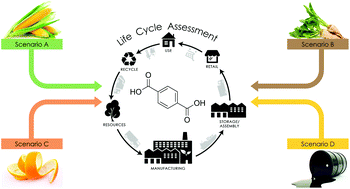Terephthalic acid from renewable sources: early-stage sustainability analysis of a bio-PET precursor†
Abstract
The present work was performed because of the paramount importance of terephthalic acid (PTA) in the current chemical industry. It represents the missing element for the production of 100% bio-PET (polyethylene terephthalate) and has a market with continuous growth. The other monomer, monoethylene glycol (MEG), is already widely available from renewable sources. Considering the wide relevance, not only scientific but also social, covered by the possibility of producing one of the most frequently used polymers from renewable sources, this analysis is aimed at the environmental assessment of alternative routes for the production of PTA. In order to do this, the life cycle assessment (LCA) methodology was adopted as a scientific tool which is able to estimate the environmental performance of three pathways from different renewable sources, comparing the results with the traditional technology. An early stage approach was used by comparing different scenarios with two independent methods: CED (cumulative energy demand) and ReCiPe. The results prove that the bio-routes to PTA could be very competitive, in particular, if organic waste streams are converted into raw materials for the production of building blocks. On the other hand, the adoption of dedicated crops has some limitations and it seems not to be the right solution to mitigate climate change by reducing fossil sources.



 Please wait while we load your content...
Please wait while we load your content...